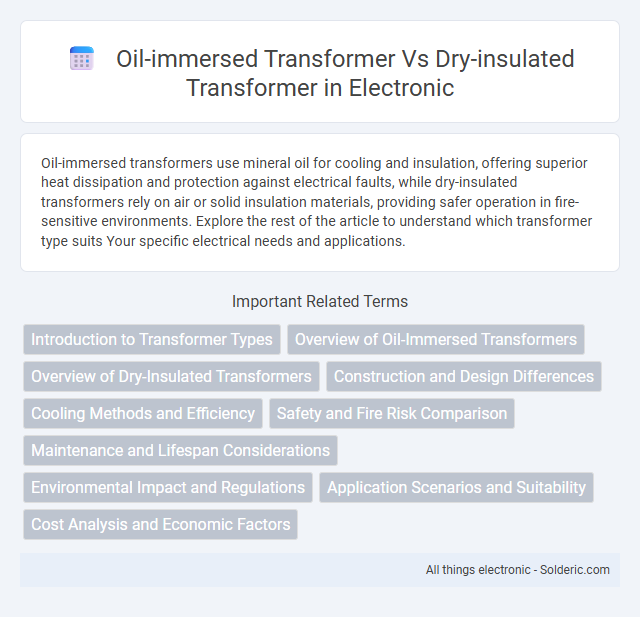Oil-immersed transformers use mineral oil for cooling and insulation, offering superior heat dissipation and protection against electrical faults, while dry-insulated transformers rely on air or solid insulation materials, providing safer operation in fire-sensitive environments. Explore the rest of the article to understand which transformer type suits Your specific electrical needs and applications.
Comparison Table
| Feature | Oil-Immersed Transformer | Dry-Insulated Transformer |
|---|---|---|
| Cooling Method | Uses mineral oil for cooling and insulation | Air-cooled with epoxy resin or cast insulation |
| Maintenance | Requires regular oil testing and monitoring | Low maintenance, no oil testing needed |
| Fire Risk | Higher fire hazard due to flammable oil | Lower fire risk, non-flammable materials |
| Environmental Impact | Oil leakage risk harming environment | Environmentally safer, no oil leakage |
| Installation Location | Preferred for outdoor and large capacity | Suitable for indoor, sensitive areas |
| Cost | Generally lower upfront cost | Higher initial cost but lower lifecycle expenses |
| Lifespan | Typically 25-30 years | Usually 20-25 years |
| Efficiency | High efficiency, good heat dissipation | Moderate efficiency, limited heat dissipation |
Introduction to Transformer Types
Oil-immersed transformers use mineral oil for insulation and cooling, offering superior thermal performance and enhanced electrical insulation, making them suitable for high-voltage applications. Dry-insulated transformers rely on solid insulators like epoxy resin or air, providing safer, maintenance-free operation with lower fire risk, ideal for indoor and environmentally sensitive locations. Your choice depends on installation environment, cooling needs, and safety requirements, balancing efficiency and operational demands.
Overview of Oil-Immersed Transformers
Oil-immersed transformers use mineral oil as an insulating and cooling medium, providing efficient heat dissipation and enhanced electrical insulation. These transformers are ideal for high voltage applications due to their superior cooling performance and longer service life compared to dry-insulated transformers. Understanding the advantages of oil-immersed transformers can help you select the right equipment for reliable power distribution in demanding environments.
Overview of Dry-Insulated Transformers
Dry-insulated transformers use solid insulation materials such as epoxy resin or cast resin instead of oil, providing enhanced safety by eliminating the risk of oil leaks and fire hazards. These transformers offer improved environmental compatibility, require less maintenance, and are suitable for indoor installations with limited space. Their design enables higher resistance to moisture, dust, and contaminants, ensuring reliable performance in harsh conditions compared to oil-immersed transformers.
Construction and Design Differences
Oil-immersed transformers use a liquid dielectric, typically mineral oil, to insulate and cool their windings, featuring sealed tanks and radiators designed for efficient heat dissipation. Dry-insulated transformers rely on solid insulation materials such as epoxy resin or pressboard and use air cooling through ventilation or fans, which eliminates the risk of oil leaks and reduces fire hazards. Your choice between these types depends on the application environment, maintenance requirements, and safety considerations linked to their distinct construction and design.
Cooling Methods and Efficiency
Oil-immersed transformers utilize mineral oil for insulation and cooling, allowing efficient heat dissipation through natural or forced oil circulation, which enhances thermal management and extends transformer life. Dry-insulated transformers employ air or epoxy resin for insulation, relying primarily on natural convection and external fans for cooling, resulting in lower thermal conductivity and generally higher operating temperatures. The superior cooling efficiency of oil-immersed transformers makes them more suitable for high-load and industrial applications, while dry transformers are favored in indoor or environmentally sensitive settings due to their reduced fire risk and maintenance requirements.
Safety and Fire Risk Comparison
Oil-immersed transformers pose a higher fire risk due to their flammable insulating oil, making them less safe in environments prone to fire hazards. Dry-insulated transformers use solid insulation materials, significantly reducing the risk of fire and enhancing safety in residential and indoor installations. Choosing a dry-insulated transformer can improve Your fire safety measures by minimizing the potential for oil leaks and combustion.
Maintenance and Lifespan Considerations
Oil-immersed transformers require regular oil testing and maintenance to monitor dielectric strength and prevent leaks, impacting their operational lifespan. Dry-insulated transformers offer lower maintenance demands due to the absence of oil, reducing fire risks and environmental concerns, thereby potentially extending service life in certain environments. Your choice between the two should consider long-term maintenance capabilities and expected durability requirements.
Environmental Impact and Regulations
Oil-immersed transformers use mineral oil for insulation and cooling, which poses risks of soil and water contamination due to potential leaks or spills, subjecting them to stringent environmental regulations. Dry-insulated transformers are more environmentally friendly, eliminating oil-related risks and often complying more easily with strict environmental standards, making them suitable for urban or ecologically sensitive areas. Your choice between these transformers impacts regulatory compliance and environmental safety considerations in your electrical infrastructure.
Application Scenarios and Suitability
Oil-immersed transformers excel in outdoor and industrial settings where high load capacity and superior cooling are essential, such as power generation plants and heavy manufacturing facilities. Dry-insulated transformers suit indoor environments with strict fire safety regulations, including commercial buildings and hospitals, due to their non-flammable dielectric material. Selection depends on factors like environmental conditions, maintenance capabilities, and safety requirements, with oil-immersed types favored for robustness and dry transformers preferred for low-risk, space-constrained applications.
Cost Analysis and Economic Factors
Oil-immersed transformers generally offer lower initial costs compared to dry-insulated transformers due to simpler manufacturing processes and better thermal efficiency, resulting in reduced cooling requirements. You should consider operational expenses as well; oil-immersed units require regular oil maintenance and monitoring, whereas dry-insulated transformers have higher upfront costs but lower maintenance expenses and longer lifespan in harsh environments. Economic factors such as installation environment, safety regulations, and total cost of ownership over the transformer's lifecycle heavily influence the choice between these two transformer types.
oil-immersed transformer vs dry-insulated transformer Infographic

 solderic.com
solderic.com